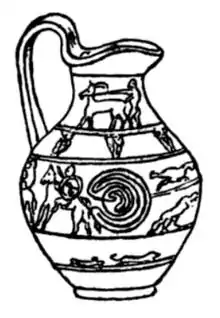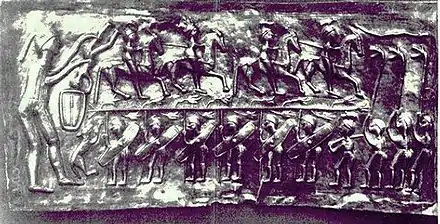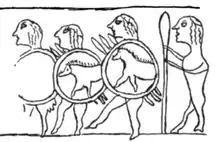Lusus Troiae
The Lusus Troiae, also as Ludus Troiae and ludicrum Troiae ("Troy Game" or "Game of Troy") was an equestrian event held in ancient Rome. It was among the ludi ("games"), celebrated at imperial funerals, temple foundings, or in honor of a military victory. The lusus was occasionally presented at the Saecular Games, but was not attached regularly to a particular religious festival.[1]


Participation was a privilege for boys of the nobility (nobiles).[2] It was a display of communal skill, not a contest.[3]
Description
The fullest description of the exercise is given by Vergil, Aeneid 5.545–603, as the final event in the games held to commemorate the anniversary of the death of Aeneas's father, Anchises. The drill features three troops (turmae) — each made up of twelve riders, a leader, and two armor-bearers — who perform intricate drills on horseback:
- … The column split apart
As files in the three squadrons all in line
Turned away, cantering left and right; recalled
They wheeled and dipped their lances for a charge.
They entered then on parades and counter-parades,
The two detachments, matched in the arena,
Winding in and out of one another,
And whipped into sham cavalry skirmishes
By baring backs in flight, then whirling round
With leveled points, then patching up a truce
And riding side by side. So intricate
In ancient times on mountainous Crete they say
The Labyrinth, between walls in the dark,
Ran criss-cross a bewildering thousand ways
Devised by guile, a maze insoluble,
Breaking down every clue to the way out.
So intricate the drill of Trojan boys
Who wove the patterns of their prancing horses,
Figured, in sport, retreats and skirmishes …[4]
Complex intertwining manoeuvres as a display of horsemanship were characteristic of Roman cavalry reviews on the parade ground. The Greek military writer Arrian describes these in his book The Art of Military Tactics (Technē Taktikē), and says they originated among the non-Roman cavalry units provided by the allies (auxilia), particularly the Gauls (that is, the continental Celts) and Iberians.[5] The Troy Game, however, was purely ceremonial and involved youths too young for military service.
History and origin
The lusus Troiae was "revived" by Julius Caesar in 45 or 46 BC,[6] perhaps in connection with his family claim to have descended from Iulus, the son of Aeneas who in the game of the Aeneid rides a horse that was a gift from the Carthaginian queen Dido.[7] Given the mythological setting, the description of the lusus Troiae in the Aeneid is likely to have been the Augustan poet's fictional aetiology.[8] Historically, the event cannot be shown to have been held before the time of Sulla,[9] and it has been doubted that the lusus presented under Sulla was the Troy Game. A similar-sounding event during the ludi Romani at the time of the Second Punic War is also uncertain as evidence for an earlier staging.[10]


The claim that the event "extends back at least to the sixth century B.C." is based in part on a late 7th-century Etruscan wine-server (oinochoë) from Tragliatella (near Caere) which depicts mounted youths emerging from a labyrinth with the legend TRUIA, one possible meaning of which is Troy.[11] Vergil explicitly compares the patterns of the drill to the Cretan Labyrinth, which was associated with the geranos ("crane dance") taught by Theseus to the Athenian youth he rescued from the Minotaur there. In myth and ritual, the labyrinth, and hence the lusus, has been interpreted as "a return from danger, a triumph of life over death,"[12] or more specifically as an initiation ritual.[13] The geranos of Theseus serves as a "mythic prototype for the escape of initiates from the rigors of initiation"; the feet of the shield-bearers on the Truia wine-server may suggest dance steps.[14] Initiation iconography similar to that of the Etruscan oinochoë is found on a panel of the Gundestrup Cauldron, generally regarded as presenting Celtic subject matter with a Thracian influence in workmanship.[15] At least one of the Celtic polities of central Gaul, the Aedui, claimed like the Romans to be of Trojan descent and were formally recognized by the Roman senate as the "brothers" as well as the allies of Rome long before they were incorporated into the empire.[16]
The Etruscan designation of the game as "Truia", if that is what the vase depicts, may be a play on words, as truare means "to move," with a specialized sense in the vocabulary of weaving: it has been argued that the lusus Troiae is the "running thread game," intended to repair the "social fabric" of Rome after the recent civil wars.[17] The Troy Game was performed on a purification day (dies lustri).[18] Vergil uses two forms of the verb "to weave" to describe the equestrian movements, and in some versions of the Theseus myth, the hero's return from the labyrinth is made possible by following a daedalean thread provided by Ariadne.[19] The game may have connections to Mars, who was associated with horses through his Equirria festivals and the ritual of the October Horse, as a patron of warrior youth. Mars' youthful armed priests the Salii performed dance steps expressed by forms of the verb truare, here perhaps meaning "to perform a truia dance." The Troy Game was supervised by the Tribunes of the Celeres, who are connected to the Salii in the Fasti Praenestini.[20]
Augustus established the lusus Troiae as a regular event.[21] Its performance was part of a general interest in Trojan origins reflected also in the creation of the Tabulae Iliacae or "Trojan Tablets," low reliefs that illustrate scenes from the Iliad and often present text in the form of acrostics or palindromes, suggesting patterned movement or literary mazes.[22]
The young Tiberius led a turma at the games celebrating the dedication of the Temple of the Divine Julius, 18 August 29 BC.[23] The lusus was also performed at the dedication of the Theater of Marcellus in 13 BC,[24] and of the Temple of Mars Ultor, 1 August 2 BC.[25] The children in eastern dress on the Ara Pacis have sometimes been interpreted as Gaius and Lucius Caesar in "Trojan" garb for the game in 13 BC.[26] The Troy Game continued to be staged under other emperors of the Julio-Claudian dynasty.[27] Seneca mentions the event in his Troades (line 778). Nero participated in 47 AD, at the age of nine, along with Britannicus.[28]
See also
References
- Daniel P. Harmon, "The Religious Significance of Games in the Roman Age," in The Archaeology of the Olympics (University of Wisconsin Press, 1988), p. 250.
- John Scheid and Jesper Svenbro, The Craft of Zeus: Myths of Weaving and Fabric (Penn State Press, 1996), p. 41.
- Francis Cairns, Virgil's Augustan Epic (Cambridge University Press, 1989, 1990), pp. 226 and 246 online.
- Translation by Robert Fitzgerald of Vergil, Aeneid 5.580–593: olli discurrere pares atque agmina terni / diductis soluere choris, rursusque uocati / conuertere uias infestaque tela tulere. / inde alios ineunt cursus aliosque recursus / aduersi spatiis, alternosque orbibus orbis / impediunt pugnaeque cient simulacra sub armis; / et nunc terga fuga nudant, nunc spicula uertunt / infensi, facta pariter nunc pace feruntur. / ut quondam Creta fertur Labyrinthus in alta / parietibus textum caecis iter ancipitemque / mille uiis habuisse dolum, qua signa sequendi / frangeret indeprensus et inremeabilis error; / haud alio Teucrum nati uestigia cursu / impediunt texuntque fugas et proelia ludo.
- As described by Arrian, Technē Taktikē (Latin Ars tactica) 32–44; see description and diagram, Brian Campbell, Greek and Roman Military Writers: Selected Readings (Routledge, 2004), p. 44 online, and A.M. Devine, “Arrian’s Tactica,” Aufstieg und Niedergang der römischen Welt II.34.1 (1993), p. 331 online.
- Suetonius, Divus Iulius 39; Cassius Dio 43.23.6.
- Vergil, Aeneid 5.570–572; Petrini, The Child and the Hero, p. 35.
- Mark Petrini, The Child and the Hero: Coming of Age in Catullus and Vergil (University of Michigan Press, 1997), p. 93 online.
- The evidence for the game under Sulla is Plutarch, Cato Minor 3. Unless otherwise noted, citations of sources from Atze J. Keulen, L. Annaeus Seneca: Troades (Brill, 2001), p. 403 online.
- Scheid and Svenbro, The Craft of Zeus, p. 40.
- Harmon, "The Religious Significance of Games in the Roman Age," p. 249 online. The Truia wine-server has been regarded as a key piece of evidence in tracing the spread of the Cretan Labyrinth design from Greece first into Etruscan Italy and from there into central and northern Europe, the British Isles, and Iberia; see John L. Heller and Stewart S. Cairns, "To Draw a Labyrinth," in Classical Studies Presented to Ben Edwin Perry by His Students and Colleagues at the University of Illinois, 1924–60 (University of Illinois Press, 1969), pp. 236–262, on the Truia labyrinth especially pp. 236, 238, 261–262, and Heller again, "A Labyrinth from Pylos?" American Journal of Archaeology 65 (1961) 57–62.
- Harmon, "The Religious Significance of Games in the Roman Age," p. 250.
- H.S. Versnel, "Apollo and Mars One Hundred Years after Roscher," in Visible Religion: Annual for Religious Iconography. Approaches to Iconology (Brill, 1985–86), p. 148 online.
- Thomas Habinek, The World of Roman Song: From Ritualized Speech to Social Order (Johns Hopkins University Press, 2005), pp. 18–19 online, where the Truia vessel is discussed at greater length, with more on the crane dance and the labyrinth pp. 1950–1951.
- Kim R. McCone, “Werewolves, Cyclopes, Díberga, and Fíanna: Juvenile Delinquency in Early Ireland,” Cambridge Medieval Celtic Studies 12 (1986) 1–22; John T. Koch, Celtic Culture: A Historical Encyclopedia (ABC-Clio, 2006), pp. 908 online and 1489–1490.
- Aeduos fratres consanguineosque saepe numero a senatu appellatos: Julius Caesar, Bellum Gallicum 1.332, see also 1.36.5, 43.6, 44.9. There is some possibility that the Aeduan "senate," as Caesar refers to their equivalent political body, is meant. The most explicit claim of Trojan origin for the Aedui is made by Ammianus Marcellinus 15.9.5. A similar claim is made for the Arverni by Lucan and Sidonius Apollinaris. For full discussion of the evidence, see D.C. Braund, "The Aedui, Troy, and the Apocolocyntosis," Classical Quarterly 30 (1980) 420–425.
- Scheid and Svenbro, The Craft of Zeus, pp. 45–48.
- Seneca, Troades 777f.
- Textum (5.589) and texunt (5.593). Claudian describes a similar event in his Panegyric on the Sixth Consulship of the Emperor Honorius, Bill Thayer's edition at LacusCurtius, English translation and Latin line 615ff., where the "interwoven retreats" (textas … fugas, 623) are also compared to the Cretan (as Gortynia) labyrinth and to the course of the Meander River (hence English "meander") near Troy.
- H.S. Versnel, "Apollo and Mars One Hundred Years after Roscher," in Visible Religion: Annual for Religious Iconography. Approaches to Iconology (Brill, 1985–86), p. 148, citing Festus 270 (Müller).
- Frequentissime: Suetonius, Augustus 43.
- Thomas Habinek, "Situating Literacy at Rome," in Ancient Literacies: The Culture of Reading in Greece and Rome (Oxford University Press, 2009), pp. 127–129 online, including a diagram; Piotr Rypson, "Homo quadratus in labyrintho: The Cubus Visual Poem from Antiquity until Late Baroque," European Iconography East and West. Selected Papers of the Szeged International Conference June 9–12, 1993 (Brill, 1996), p. 10 online.
- Cassius Dio 51.22; Geoffrey S. Sumi, Ceremony and Power: Performing Politics in Rome between Republic and Empire (University of Michigan Press, 2005), p. 23.
- Cassius Dio 54.26.1; Suetonius, Augustus 43.5; Lawrence Richardson, A New Topographical Dictionary of Ancient Rome (Johns Hopkins University Press, 1992), p. 382.
- Kathleen M. Coleman, "Euergetism in Its Place: Where Was the Amphitheatre in Augustan Rome?" in Bread and Circuses: Euergetism and Municipal Patronage in Roman Italy (Routledge, 2003), p. 76.
- I.M. Le M. Du Quesnay, Horace, Odes 4.5: Pro Reditu Imperatoris Caesaris Divi Filii Augusti," in Homage to Horace: A Bimillenary Celebration (Oxford: Clarendon Press, 1995), p. 143; Mario Torelli, Typology and Structure of Roman Historical Reliefs (University of Michigan Press, 1992), pp. 48–49, 60 online. Charles Brian Rose, "The Parthians in Augustan Rome," in American Journal of Archaeology 109 (2005), pp. 36–44, argues at length against this identification, but discusses "the uneasy interaction of Trojan and Parthian iconography" that can conflate "the founders of the Romans or their fiercest opponents."
- Suetonius, Tiberius 6, Caligula 18, Claudius 21, Nero 7.
- Keulen, L. Annaeus Seneca: Troades, p. 9; Suetonius, Nero 7; Tacitus, Annales 11.11.5 (where the event is called ludicrum Troiae). The semiotics of Nero's participation is analyzed at length by Ellen O'Gormon, Irony and Misreading in the Annals of Tacitus (Cambridge University Press, 2000), pp. 162–175.
